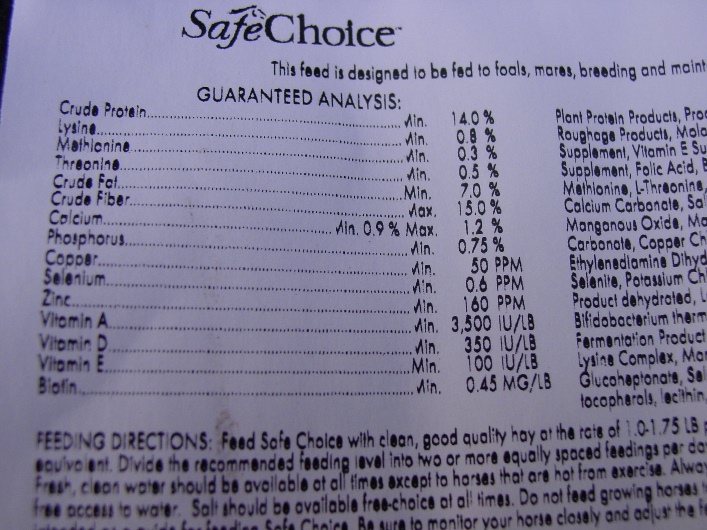What Makes it ‘Premium’ Nutrition?

Aside from price, how do you know if a feed that is advertised as premium nutrition, really is? Here are some tips to help you decode the premium puzzle.
First, a word about forage… Forage, being hay and/or pasture, should make up the majority of your horse’s diet. Therefore, the amount of effort and investment you make in your feeding program should be heavily weighted toward offering your horse the best quality forage you have access to. Your feed selection should complement your forage. Feed or supplemental fortification should fill gaps in forage nutrition, but the most important aspect is the quality of forage, as that makes up the majority of your horse’s source of energy. Always consider your horse’s forage first and foremost.
What is on a tag? Onto the feed concentrate; the most important aspect of your feed choice is the nutrients the feed will provide for your horse. When you buy premium nutrition, you expect to get premium results…but, what you pay for may or may not be what you get. So how can you tell?
First, check the tag for guaranteed analysis of nutrients. A premium feed will be formulated to deliver your horse the optimal nutrition for their age and activity level. Each horse varies to some degree in their metabolism and requirements, but in most cases, optimal nutrition will be formulated to provide the most digestible nutrients in levels that ensure your horse makes the most of every meal.
With regard to nutrient levels, is more actually better? Not always. Sometimes more is just more. Take into consideration minerals. Mineral fortification of a diet is only as good as the amount that is absorbed, so having more copper, zinc or manganese listed on the tag doesn’t mean that your horse is making use of it all. Look for key words that indicate digestibility; for minerals, ‘organic’ means the mineral is tied to an amino acid and is readily absorbed. For proteins, look for guaranteed levels of ‘lysine’, ‘methionine’ and ‘threonine’. These are the protein components that matter most to your horse. Sometimes more is just…well more.
In the scoop…Another way to compare feeds is to determine how much you have to feed to give your horse the optimal level of nutrients guaranteed on the tag. Most feed companies formulate their rations to provide an amount of digestible energy (DE) which determines the rate (or amount) which they recommend you feed. All other nutrients, such as the vitamins and minerals, are concentrated based on that feeding rate.
For example, you have two different feeds you are considering for your horse who is at a ‘maintenance’ level energy requirement (meaning to keep his body condition score at or about a 6). Feed A recommends you give him 2.5 pounds per day, while feed B recommends you feed a minimum of 4 pounds per day. Keep in mind that if you feed less than the recommended 4 pounds of feed B, not only will your horse not get the DE for his activity level, he will also not get the optimal amount of vitamins, minerals and amino acids (if they are guaranteed). Keep in mind percentages on the tag are only as good as the rate at which they are fed.
Functional Ingredients…There are ingredients that provide the diet with big nutrients such as fat, fiber and protein. There are ingredients that provide micro nutrients, such as minerals and vitamins. And then there is a whole other class of ingredients are called ‘functional’ ingredients. These items are intended to enhance the efficiency or digestibility of the feed, meaning your horse gets more out of every bite. Consider prebiotics and probiotics for example. Through research, both of these functional ingredients have shown to enhance the digestibility of many nutrients and improve overall gut health. The addition of prebiotics and probiotics to a diet is intendedto aid your horse in getting that optimal nutrition for a premium result!
Valid Research… One last thing to take into consideration; a feed brand or company that has a research program is far more likely to understand the digestibility of ingredients and the nutrient requirements of the horse, versus a company that does not conduct research. Many aspects of optimal nutrition, such as understanding digestibility, aren’t found on a tag, but are proprietary to the researching company. Before you consider a feed that is advertised ‘just as good as, only cheaper’, consider what makes the real deal. In most cases, a company that copy-cats a popular product doesn’t get you to the same level of quality, premium nutrition as the original.
So, is it really a premium feed? Check the tag to find out. Armed with this information, you can answer this question for yourself!
